Understanding the iPhone Charger USB-C Plug
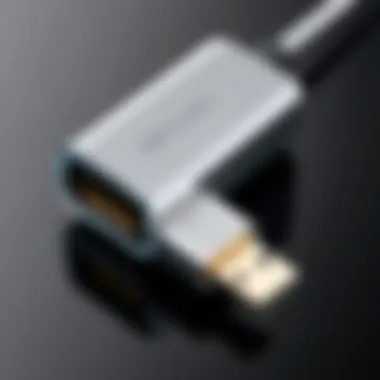
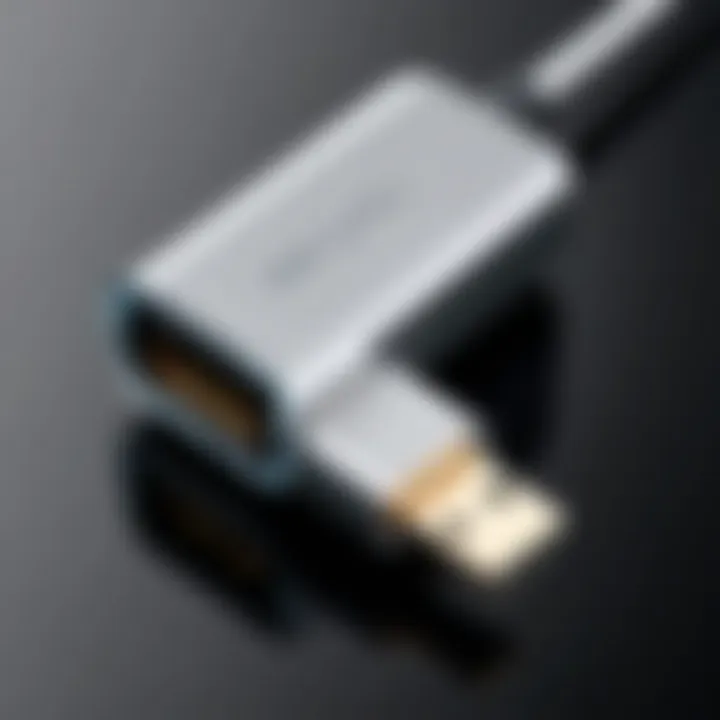
Intro
The advent of the USB-C plug has marked a significant transition in the world of mobile device charging, particularly for Apple's iPhone series. The shift to USB-C reflects a broader industry trend towards universal charging standards, which aim to simplify user experience while enhancing device interoperability. This transition not only speaks to convenience but also touches on the implications for efficiency and sustainability in the tech ecosystem.
Understanding the specifications, compatibility, and overall advantages of the iPhone charger USB-C plug is essential for end-users and IT professionals alike. This article delves deeply into the USB-C technology surrounding the iPhone, providing insights that will aid both casual users and tech enthusiasts in making informed decisions about their devices and accessories.
Prologue to USB-C Technology
Understanding USB-C technology is crucial for current and future charging solutions. USB-C represents a significant advancement in the realm of connectivity, offering faster, more reliable, and more versatile options for both charging devices and data transfer. As the iPhone adopts USB-C, it is essential to grasp its implications not only for Apple users but for the technology industry as a whole. This section will outline the key elements, benefits, and considerations that define USB-C.
Overview of USB-C
USB-C, or Universal Serial Bus Type-C, is a connector standard introduced in 2014. It is reversible, meaning it can be plugged in either way, simplifying the user experience. USB-C supports a variety of protocols, enabling it to work with different types of devices and interfaces, including HDMI, DisplayPort, and power delivery. This versatility is one of USB-C's main advantages. Additionally, it can deliver substantial power, making it suitable for charging both small devices like smartphones and larger devices like laptops.
Evolution of Charging Interfaces
The transition from previous charging interfaces to USB-C illustrates the need for greater efficiency in power delivery and data transfer. Initially, the micro-USB and Apple's proprietary Lightning connectors dominated the landscape. However, these options had limitations in terms of power output and compatibility. The development of USB-C was a response to these constraints. It incorporates faster charging, improved data rates, and enhanced compatibility across multiple devices. This evolution signifies a movement toward a more standardized and simplified approach to charging technology.
Significance of USB-C in Modern Devices
In modern tech, USB-C has become increasingly prevalent. Many devices, not just smartphones, now utilize this standard. From laptops to tablets and accessories, the integration of USB-C ensures seamless connectivity across various platforms. For iPhone users, adopting USB-C enhances functionality by allowing users to connect to a broader range of devices. This shift promotes innovation and encourages manufacturers to create more efficient products. Ultimately, USB-C symbolizes a move toward universal charging solutions in an ever-evolving technological landscape.
iPhone Charger USB-C Plug Specifications
The specifications of the iPhone charger USB-C plug are crucial as they define its functionality and performance. Understanding these specifications helps users and IT professionals make informed choices when selecting cables and charging devices. Key elements include technical details and physical design aspects that not only impact speed but also compatibility and longevity of the accessories utilized with iPhones.
Technical Details
Pin Configuration
The pin configuration of the iPhone charger USB-C plug plays a vital role in its function. A standard USB-C connector features twenty pins, which is markedly different from older USB types. This design allows for reversible plugging, meaning there is no need to check the orientation while inserting the connector. Such convenience elevates the user experience.
The versatility of this pin arrangement supports various power and data transmission capabilities. One notable feature is the ability to handle different power levels efficiently. This characteristic is particularly beneficial in minimizing the risk of overheating during use. However, the dependence on proper pin alignment can occasionally pose challenges, like reduced effectiveness when using low-quality or incompatible accessories.
Power Delivery Standards
Power delivery standards define how much power can be delivered through the USB-C connection. This capability is a significant improvement over previous USB versions, enabling faster charging times and the ability to deliver power to various devices. For instance, the iPhone charger USB-C plug can support up to 100 watts, accommodating not just iPhones but a wider range of devices, including laptops.
A key characteristic of these standards is the smart negotiation process that occurs between devices, ensuring the appropriate power level is delivered. This feature enhances safety and efficiency, reducing the chances of battery damage over time. Nonetheless, users must be cautious as not all cables and adapters support the maximum power delivery capabilities.
Data Transfer Rates
Data transfer rates are essential for those using the USB-C plug for tasks beyond charging. The iPhone charger USB-C plug can offer high data transfer speeds, reaching up to 10 Gbps with USB 3.2 standards. This is advantageous when transferring large files between devices quickly.
This capability ensures that users working with high-resolution videos or large applications find the iPhone both functional and efficient. However, to achieve these speeds, using certified and quality accessories is necessary, as cheap alternatives may cap the speed significantly.
Physical Design Aspects
Connector Design
The connector design of the iPhone charger USB-C plug is compact and sleek, contributing to its ease of use and compatibility across a wide range of devices. The minimalist design embodies practicality without compromising on features. A distinctive aspect is the equal size of both ends of the connector, permitting reversible orientation.
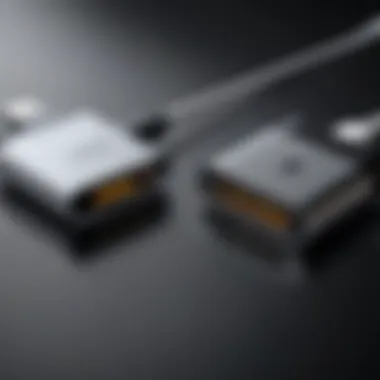
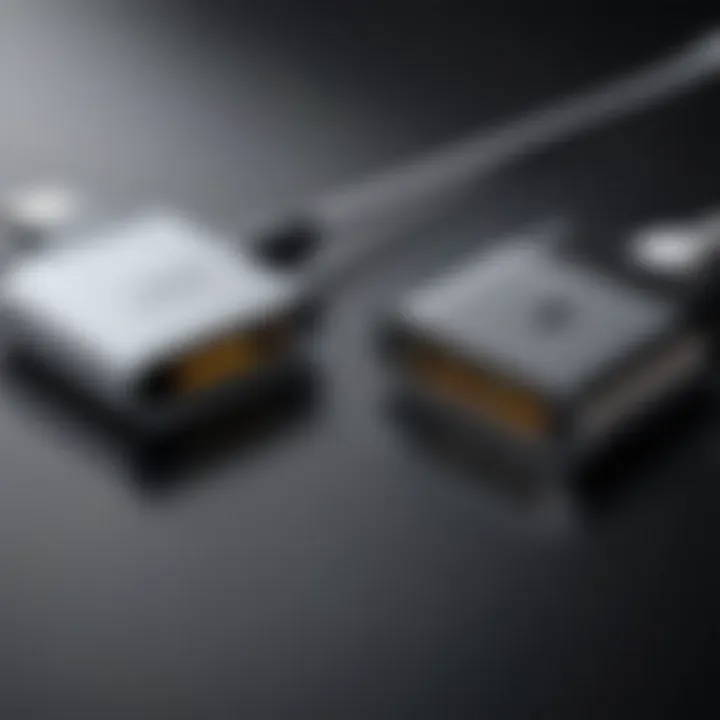
This design not only enhances the overall aesthetics but also simplifies user interaction. Users can plug in the charger without concern for which side is up. Nevertheless, this requires careful handling, as the compact design can make the connectors more susceptible to wear if not treated properly.
Durability Considerations
Durability is another critical aspect of the iPhone charger USB-C plug. Designed for repeated use, these connectors generally withstand a considerable number of insertions, often rated for over 10,000 cycles. This longevity makes them a cost-effective long-term investment for users.
The robustness of materials used in the construction of these plugs also plays a part in their overall resilience against wear and tear. However, users need to be aware that not all USB-C cables are created equal. Some lower quality options may not offer the same level of durability, leading to issues like fraying or malfunction over time.
"Selecting quality accessories ensures the optimal performance of your USB-C charger and prolongs the life of your devices."
Overall, grasping the specifications of the iPhone charger USB-C plug is essential for maximizing its benefits and ensuring seamless compatibility with various devices.
Compatibility Factors
Understanding compatibility factors is crucial when discussing the iPhone charger USB-C plug. These elements outline how the USB-C technology interacts with various devices, ensuring users know what to expect regarding performance and usability. In today’s technological landscape, where multiple devices from different manufacturers co-exist, compatibility becomes a focal point for both consumers and IT professionals alike.
Devices Supporting USB-C Charging
Apple Devices
Apple has recommended the use of USB-C across many of its newer products, which adds a significant layer of convenience for users. The transition from proprietary connectors to USB-C reflects Apple's commitment to a standardized charging solution. Key characteristics of USB-C in Apple devices include faster data transfer rates and improved power delivery capabilities. With the right adapter, devices such as the iPad Pro, MacBook, and iPhone can share power and data seamlessly.
One unique feature of Apple’s approach is the implementation of Power Delivery. This technology allows devices to negotiate the amount of power they receive, enhancing charging efficiency. However, it is essential to note that not all Apple devices benefit equally from USB-C’s full capabilities. For instance, older models may not support the fastest charging speeds available.
Third-Party Products
The ecosystem for USB-C charging is extensive, with countless third-party products entering the market. These include chargers, cables, and accessories that offer compatible options for users seeking varied solutions. A notable characteristic of third-party products is their often lower price points compared to original Apple accessories.
This diversification provides users with multiple choices. However, the unique feature to be cautious of is the variability in quality among these products. Not all third-party manufacturers comply with the USB-C specifications established by the USB Implementers Forum, leading to potential compatibility issues. Investing in quality products, even if they are from third-party sellers, can significantly enhance the user experience while mitigating risks.
Cross-Device Charging Capabilities
The cross-device charging capabilities of USB-C represent a significant innovation in terms of convenience. Users can charge not only their iPhones but also various other devices like laptops, tablets, and even some peripherals using a single cable type. This universality can declutter workspaces and reduce the number of cables and chargers users need to carry.
Moreover, the ability to charge different devices with one cable adds accessibility, allowing for quick power-sharing between devices during critical moments. While this functionality is predominantly beneficial, it does hold the challenge of managing charging priorities among devices. Certain protocols may limit the power output for lower priority devices. Awareness of these factors helps users utilize their charging solutions more effectively.
Advantages of USB-C for iPhone Users
The move to USB-C for iPhone users presents several compelling benefits that improve user experience, simplify charging, and enhance the product's utility in a world increasingly oriented around universal standards. Understanding these advantages is crucial for both daily users and IT professionals who seek to optimize device management in various settings.
Faster Charging Times
One of the most significant benefits of using the USB-C plug is the enhanced charging speed it offers. USB-C technology supports Power Delivery, which allows for higher wattage delivery. This means that devices can charge faster than with previous methods, such as the Lightning connector. For instance, charging an iPhone with a USB-C power adapter rated at 20W or higher can significantly shorten the time needed to reach full battery capacity. Many users have noted the value of getting a significant charge in a short time, especially when on the go.
Higher charging speeds are not just a convenience; they can facilitate better device management during busy days. Users can spend less time tethered to power sources, allowing for increased mobility and productivity. This transition to faster charging should be a primary consideration for any iPhone user evaluating their charging solutions.
Universal Compatibility
Another key advantage of USB-C is its universal compatibility across a wide range of devices. Many manufacturers have adopted USB-C as the standard connector for smartphones, laptops, and other electronic gadgets. This results in the potential for using a single cable for multiple devices, which simplifies the charging process significantly.
For IT professionals, this compatibility extends to work environments where different devices are frequently used. Having standardized connectors reduces the complexity of managing various cables and devices. Rather than carrying multiple proprietary chargers, users can rely on USB-C chargers for any compatible device, streamlining operations.
Enhanced Longevity of Cables
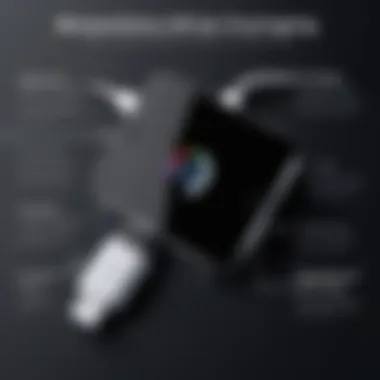
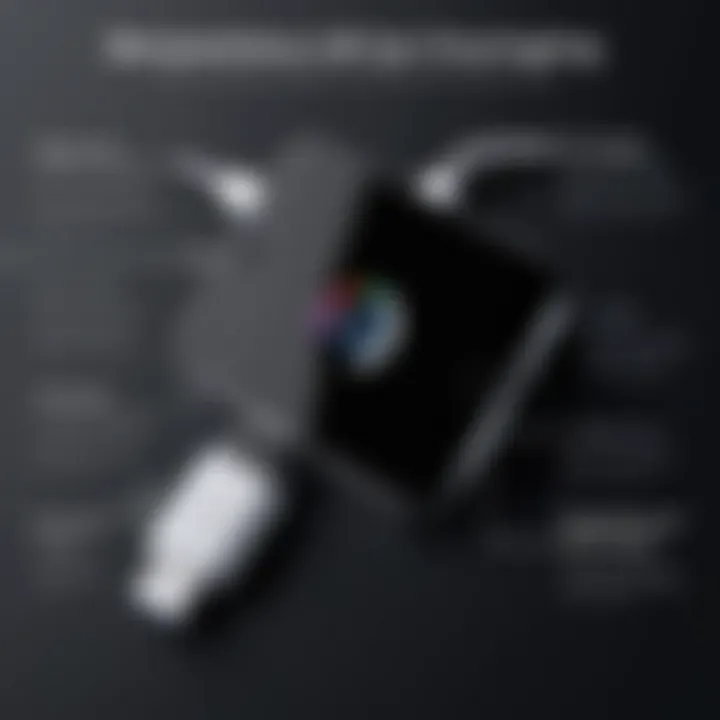
The construction of USB-C cables also contributes to their durability. Typically, these cables are designed to withstand wear and tear better than previous versions. With proper handling, they tend to last longer, reducing the need for frequent replacements. In office settings, where charging needs can be more intensive, this longevity can lead to lower overall costs.
Additionally, the robust nature of USB-C cables means they are less likely to fracture at the connectors. This is crucial, as physical damage to cables is one of the main reasons for charger replacements.
"The overall performance of USB-C technology provides users with reliability, compatibility, and efficiency that previous charging methods couldn't match."
These advantages make USB-C an attractive option for iPhone users. As technology continues to evolve, understanding these benefits will support better decisions when selecting charging solutions.
Challenges and Limitations of USB-C
The USB-C standard brings many beneficial advances, but it is not without its challenges and limitations. Understanding these issues is crucial for users and IT professionals. While USB-C aims for universal compatibility, it presents several obstacles that can complicate everyday usage. This section highlights key aspects, such as potential compatibility issues and the variance in accessory quality. Being informed about these factors allows consumers to make better decisions regarding their purchasing and usage of USB-C technology.
Potential Compatibility Issues
Despite its universal appeal, USB-C is not fully compatible across all devices. Various protocols in USB-C technology can lead to confusion. For example, not all USB-C ports support power delivery, which means devices may charge slower than expected or might not charge at all. Furthermore, some cables may carry data but not power. This can lead to frustration for users who assume that all USB-C connectors operate the same way. Users should pay close attention to device specifications to avoid incompatibility problems.
Another significant compatibility concern is with older hardware. Many legacy devices still rely on previous USB standards. These devices might not work with USB-C without an appropriate adapter. The lack of comprehensive backward compatibility represents a challenge for individuals or organizations holding on to older models while trying to integrate newer technology.
Quality Variability in Accessories
The market for USB-C accessories is vast and diverse, but it comes with another challenge: quality variability. Not all third-party cables and chargers are made to the same standards. This inconsistency can compromise performance, safety, and longevity. Some cheap cables may not support fast charging or data transfer at higher speeds.
Users have reported using non-certified cables that damage their devices. The USB Implementers Forum (USB-IF) offers a certification program for accessories, but many products bypass these standards. Therefore, discerning which accessories to choose can be challenging. It’s advisable for consumers to select reputable brands and to pay attention to certification labels to minimize the risk of damage.
"Investing in certified accessories can save users from potential compatibility and quality issues, ensuring the safety of their devices."
In summary, the challenges associated with USB-C can complicate an otherwise streamlined charging experience. Potential compatibility issues and variability in accessory quality require careful consideration. Users are encouraged to stay informed and choose quality products to maximize the benefits of USB-C technology.
Cost Considerations
Cost considerations are an essential factor when evaluating the iPhone charger USB-C plug. For both consumers and IT professionals, understanding the financial implications can influence decisions on charger purchases and necessary accessories.
Evaluating the pricing of USB-C chargers can reveal trends in the marketplace, including variations in quality and functionality. Exploring these cost-related aspects allows users to weigh the financial benefits against the advantages gained from utilizing this technology.
Price Comparison with Previous Models
When comparing prices of USB-C chargers to their predecessors, such as the Lightning connectors, noticeable differences emerge. The Apple 20W USB-C Power Adapter, for instance, features a price point that is somewhat higher than older chargers with Lightning connections. However, the increase in cost is often justified by improved performance and compatibility with a wider range of devices.
These new chargers support higher wattages, allowing for faster charging, which can lead to time savings over the long run. Here's a breakdown of some common price points:
- iPhone Lightning Chargers: $19 - $39
- USB-C Chargers: $19 - $49
While the price of USB-C chargers may appear higher initially, their ability to deliver more power can enhance the charging experience significantly. This shift in price dynamics reflects broader industry changes, as manufacturers move away from legacy solutions towards more efficient technologies.
Long-Term Value Assessment
Investing in USB-C technology can be assessed not just by the sticker price but also by the long-term value it provides. USB-C chargers typically last longer than their predecessors due to enhanced durability and versatility. This means less frequent replacement, ultimately saving costs over time.
Considerable options allow users to charge multiple types of devices with a single adapter. This universality simplifies users' tech ecosystems while reducing clutter and the need for several different chargers. Prospective buyers should think about how often they might need to replace older models as highlights:
- Durability: USB-C connectors are often made with robust materials, leading to a longer lifespan.
- Versatility: They can charge various devices like laptops, tablets, and smartphones.
- Efficiency: Faster charging translates to less downtime waiting for devices to power up.
Investing in quality accessories may cost more upfront but enhances overall user experience and reduces future expenses.
In summary, while USB-C chargers might show a higher initial cost, the combination of durability, speed, and versatility contributes to a favorable long-term assessment. Making informed choices can ultimately lead to better satisfaction and financial savings.
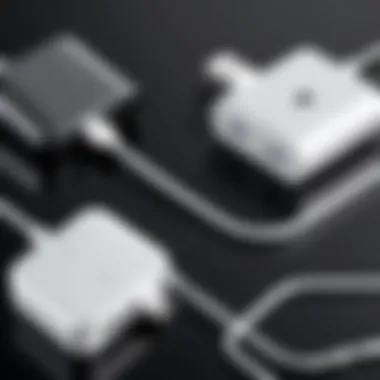
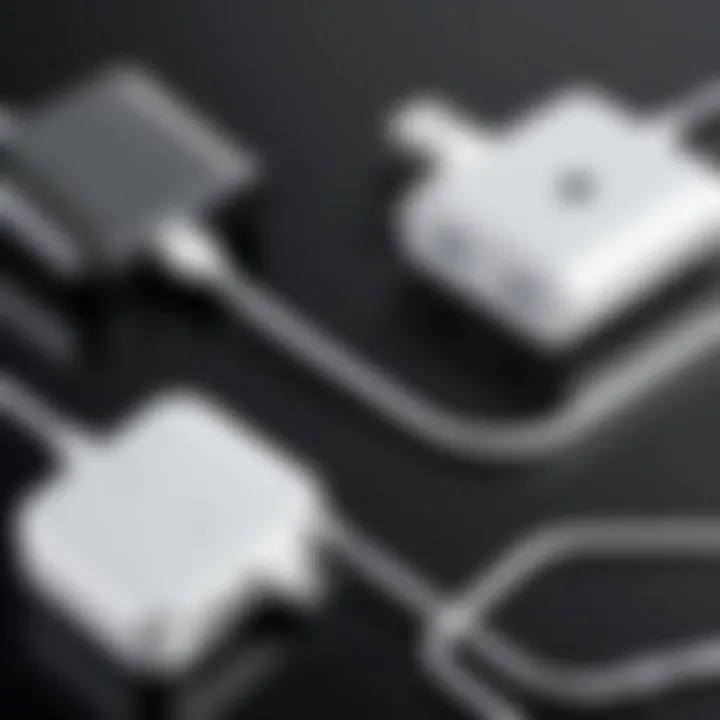
Environmental Impact of USB-C Charging
As technology advances, the importance of considering environmental implications has become paramount. The shift to USB-C charging is not just a technical evolution but also a step towards achieving sustainability in the tech world. This section discusses the broader perspective of the environmental impact of USB-C charging, addressing sustainability considerations and the recyclability of materials involved in the production and disposal of USB-C chargers.
Sustainability Considerations
USB-C technology introduces several sustainability benefits by reducing waste and promoting more efficient energy consumption. One of the key advantages is the universal compatibility offered by USB-C, which means consumers can use a single charger for multiple devices. This reduces the necessity for multiple chargers that typically end up in landfills.
Moreover, USB-C employs more efficient power delivery methods. Devices can negotiate the power needed for charging, leading to less energy waste. For instance, when charging an iPhone with a USB-C charger, the device receives only the amount of power it requires, as opposed to older charging standards that could deliver excess power, generating unnecessary energy loss.
Another sustainability factor worth noting is the potential for reduced manufacturing impact. A unified charging standard can streamline the production process and minimize the number of different charger models produced, which in turn may contribute to a lower carbon footprint in manufacturing.
Recyclability of Materials
The recyclability of materials used in USB-C chargers plays a significant role in addressing the environmental impact of electronic waste. Many USB-C products use materials such as copper, aluminum, and plastics, all of which can be recycled. However, the effectiveness of recycling programs greatly varies by region.
Manufacturers are increasingly recognizing the need for responsible disposal and recycling of electronic components. For example, some companies are taking initiatives to design chargers that are easier to disassemble, thus simplifying the recycling process. Programs that encourage consumers to return old chargers for recycling are also on the rise, promoting a circular economy.
"With advancements in technology, it is essential to ensure that the products we use today do not become the environmental liabilities of tomorrow."
Future Trends in Charging Technology
The landscape of charging technology is evolving rapidly, particularly with the advent of USB-C connectors. In this section, we delve into critical future trends that shape the charging ecosystem, particularly concerning iPhone users. Understanding these trends is essential for both consumers and IT professionals, as they may dictate the direction in which accessory compatibility and charging efficiency develop.
Emerging Charging Standards
As we move further into the age of digital devices, new charging standards are emerging. These standards are designed to enhance efficiency and compatibility. For instance, the USB Power Delivery (USB PD) standard allows for higher levels of power transfer, which means fast charging capabilities are more accessible across various devices. This is crucial for users who often seek quick recharges for their devices.
Moreover, other standards such as Quick Charge and Tesla's Supercharger are also gaining traction. These innovations focus on reducing charging times while strategically managing heat. According to industry insiders, we may soon see a convergence of these charging protocols, leading to universally compatible charging experiences across different brands and product types.
In addition to these advancements, wireless charging technology is also seeing significant growth. The introduction of Qi certification has popularized this method, and there's speculation about future enhancements that allow for rapid wireless charging. However, the efficiency and practicality of these systems still require attention to ensure optimal performance.
Speculations on Apple’s Charging Strategy
Apple's approach to charging technology has always sparked considerable discussion among technology enthusiasts and professionals. With the recent adoption of USB-C for their devices, speculation arises regarding their potential next steps. Some analysts predict Apple may streamline its accessory line to focus heavily on USB-C charging solutions, prioritizing speed and efficiency.
It's reasonable to believe that Apple will continue to enhance MagSafe capabilities alongside USB-C. Users anticipate advancements that integrate these technologies. This could redefine how users charge their devices, reduce clutter, and increase the convenience factor. One aspect of speculation involves whether Apple will fully embrace universal charging standards, which would position the company as a leader in sustainable and eco-friendly practices.
The company's ongoing focus on sustainability is likely to influence its future strategies. This shift might lead to new charging solutions that favor longer-lasting quality and reduced environmental impact.
Epilogue
The conclusion of this article signifies the culmination of a thorough exploration into the iPhone charger USB-C plug. This section distills the critical insights and perspectives presented throughout the previous sections. As individuals increasingly depend on their devices, understanding the nuances of charging technology becomes essential. The shift to USB-C represents not only a technological advancement but also a consolidation of charging standards that impacts users' daily lives.
Summary of Key Points
In summarizing the key points, it is essential to highlight the following aspects:
- Universal Compatibility: USB-C has become the standard for many devices beyond just iPhones, promoting a streamlined charging experience across platforms.
- Enhanced Performance: The improvements in charging speed and data transfer rates offer significant benefits, particularly for users in professional environments.
- Future Preparedness: As USB-C evolves, being knowledgeable about its specifications and capabilities equips users to make informed decisions about their tech ecosystem.
- Environmental Impact: The potential for reduced electronic waste through standardized charging solutions aligns with sustainability goals.
Overall, familiarity with the iPhone USB-C charging interface can facilitate smarter accessory choices and enhance overall user satisfaction.
Final Thoughts on USB-C for iPhones
Considering the final thoughts on the USB-C for iPhones, it is clear that this transition marks a pivotal moment in mobile technology. The advantages substantiate the move towards a unified charging approach, addressing both user convenience and environmental challenges. While some obstacles remain, understanding the USB-C framework empowers users to navigate these challenges effectively.
As technology progresses, Apple’s adaptation of USB-C signals a shift that could redefine user interactions with their devices. This strategic move by Apple not only resonates with tech enthusiasts but also paves the way for innovation within the broader industry. Keeping abreast of developments in USB-C technology will be essential for IT professionals and consumers alike as they leverage these changes for better efficiency and improved connectivity.
"The transition to USB-C is not merely a change in plugs; it is a step toward a more cohesive and efficient technological ecosystem."



